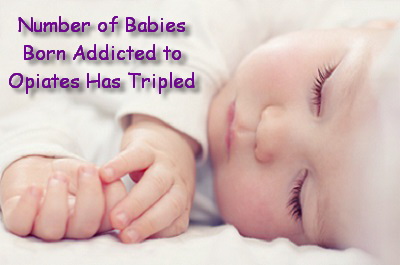You would be forgiven for thinking that the prescription drug epidemic affects only the users themselves. Abusing medicines such as Vicodin and OxyContin—opiate drugs with chemical similarities to heroin—puts the users at significant risk, killing more Americans than heroin and cocaine combined in 2008; but using when you’re pregnant presents a whole new class of risks. Babies of opiate-using mothers can be born in withdrawal, their systems shocked by the abrupt withdrawal of substances, and research has revealed that this is happening more and more frequently in the United States. In fact, three times as many babies were born with neonatal abstinence syndrome (NAS) in 2009 than in 2000, reflecting the rapid rise in the prescription drug problem.
The Study
Lead researcher Dr. Stephen Patrick had noticed an increase in the number of babies with NAS at CS Mott Children’s Hospital at the University of Michigan, and set out to determine whether the numbers were also increasing across the country. The researchers looked at discharge records from 2000, 2003, 2006 and 2009 from a database of patients that covers 44 states and over 4,100 hospitals. When the researchers determined which of the births were associated with opiate use, they revealed some shocking statistics about the extent of the problem.

They found that the number of pregnant women abusing opiate medicines when the baby was being delivered was five times higher in 2009 than in 2000. In addition, the researchers found that the rates of illicit drug use during pregnancy were 16.2 percent of teens and 7.4 percent of adults. Generally speaking—and somewhat obviously—any drug use during pregnancy poses some risk to the infant since they’re getting small doses of anything the mother takes.
As you might expect with the increase in numbers of opiate-using mothers, the number of babies born with NAS has also increased significantly. The rate almost tripled over the experimental period, from 1.20 per 1,000 births up to 3.39 in 2009. This has a disturbing parallel with the numbers of overdose deaths from prescription painkillers since the 1990s, which has also increased three-fold. The problem can’t exist in a vacuum—related issues, like babies born with NAS, are bound to increase as well.
What Is NAS?
NAS is a condition that occurs when the baby becomes addicted to drugs along with the mother when it’s in the womb. It isn’t just opiate drugs that can lead to it: marijuana, benzodiazepines, cocaine, amphetamines and the use other substances can also result in NAS. The symptoms include excessive or high-pitched crying, fever, irritability, tremors, sweating, sleep problems and sneezing or a stuffy nose.
The researchers also found that the babies born with NAS were over three times more likely to have respiratory problems and over twice as likely to have a low birth weight. Interestingly, they were also notably more likely to be covered by Medicaid, meaning that the issues were more common in low-income families.
Better Treatment or Prevention?
The researchers also looked at the average length of stay for the newborns with NAS, which they noted hasn’t decreased over the last decade. From their perspective, this represents an area in need of improvement for physicians. Since state Medicaid programs bear much of the brunt of the problem, there is a lot of motivation to improve care for opiate-addicted pregnant women. The researchers argue that since there are no standardized clinical guidelines for treatment of NAS, it is possible to improve care for the babies themselves, possibly using a combination of an opiate and another medicine such as clonidine, but breastfeeding can also help.
The other suggestion is to enroll opiate-addicted mothers in methadone programs or provide them with drugs such as buprenorphine, which is often used in cases of opiate addiction. If these interventions were successful, the numbers of babies born with NAS would decrease, rather than just the amount of time they have to spend in treatment as a result of it.
Clearly, prevention of NAS is a considerably better solution than merely determining a better way to treat babies suffering from it, but the problem impacts much more than pregnant women. The rates of prescription painkiller abuse across the U.S. are on the rise, so this research serves as yet another reason to address that problem.
Amelia liked to think of herself as a survivor—soft but strong, able to persevere. Raised by a mother with mental illness, she knew a lot about how to handle difficult people and delicate events; it seemed she’d been walking on eggshells for as long as she could remember. Her father had left when she was 12 and the care and keeping of her mother, who only grew more unstable as a result, had fallen exclusively to Amelia. By the time she was 17, she was an expert on her mother’s medical records, how and when she needed to take her medication, and was working to support the two of them. She never made it to college. Maintaining a full-time job and the constant attention required in the care of her mother didn’t leave time for school.
As anxiety settled in throughout her 20’s and with the occasional “dark moods” that lasted months sometimes, Amelia found herself less and less capable of enduring not the physical hardship, but the psychological. Still, she wanted nothing to do with therapy; why should she spend upward of $100 an hour talking about herself? Life was just the way it was. When headaches started to overtake her, she finally saw a doctor.
Offering her full history to the small town general practitioner, Amelia was persuaded to provide a background. She discussed not only her unrelenting headaches but also the steady sense that things simply weren’t right—how she shook nervously and sweated. Her GP prescribed benzodiazepines to be used for acute episodes of anxiety and opiates for what he determined were migraines.
For a while, Amelia found comfort in the hypnotic quality of the drugs. It was as if she were floating somewhere just outside herself and nothing could harm her there. As weeks and months wore on, however, Amelia discovered that the recommended dosage no longer treated her anxiety or her pain. She began to increase her dosage. When she was threatened with eviction after one of her mother’s “incidents”—she’d taken after the neighbor with a garden hoe—it all became too much. Amelia made it through the experience relatively unscathed, but she’d discovered something useful to her: her medications were more powerful when combined with wine.
It wasn’t until a friend noticed how much Amelia was taking that she questioned it herself. She realized she’d been relying exclusively on the medication and the sense of escape it gave her, taking it every four hours whether she needed to or not. But when she tried to quit she discovered something even more alarming—she couldn’t.
Gendered Differences in Addiction
The CDC reports that between 1999 and 2010, opioid overdose deaths among women increased fivefold, while the numbers for men increased three times. Since 2007, more women have died from prescription overdose than in car accident related injuries, cervical cancer or homicides. Further studies reveal that while women tend to become addicted later than men, they do so more quickly. Once addicted, women are more vulnerable to relapse, and are less likely to seek treatment than men. According to Constance Scharff, Ph.D., “Women most often use drugs to deal with stress and regulate moods.” Women are prescribed potentially addictive medications more often than men, and for longer periods. This may be because women are speaking more openly with their doctors about both physical and psychological complaints, but the reasons are not entirely understood.
Prescription drug dependence may go unnoticed even to the user—many believe that because the medications are prescribed, they are safe. When more than the recommended dosage is being used and for longer than is required and when symptoms of withdrawal (such as nausea, agitation and sleep disturbance) occur at the cessation of the medication, addiction should be considered.
High-Risk Group
Recovery from prescription drug dependence is as important as any other addictive substance or process. The White House considers women to be among the top three high-risk groups for addiction, and looking at the numbers for accidental overdose deaths, it is no wonder. Long term abuse of certain addictive prescription medications, such as the benzodiazepines, carry potential consequences: “over sedation, impairment of memory, balance and learning, depression and emotional blunting.”
Treatment for Prescription Drug Addiction
Treatment for prescription drug addiction is similar to other treatments for addiction; it consists of a behavioral component wherein addicts learn to cope with life stress or physical pain without the use of medications, and where previous users are taught to become self-observant and proactive when cravings arise. There is evidence that psychotherapy in combination with NA group attendance, or another form of collective substance abuse support, can be effective in helping women recover. Given the high pressure lives that so many modern women contend with—where work outside the home is a foregone conclusion even while work inside the home does not diminish—the stress and pain that lead many down the slippery slope of secret addiction is unsurprising. What is most important is that women like Amelia find the help they need to recover—including doctors who better understand the risks of prescribing medications known to create dependence.
Addiction can be challenging to treat, and some addictions are particularly so. For example, many individuals who enter a substance abuse treatment center for cocaine addiction and complete the treatment program soon return due to relapse. The tools acquired in treatment for dealing with cravings are sometimes not effective in patients who have a particularly challenging case of addiction to cocaine.
 A new study indicates that there may be help for those who have a cocaine addiction that does not respond to traditional treatments. While there has been little success in treating cocaine addiction with medications, the study finds that this strategy may be effective in certain situations.
A new study indicates that there may be help for those who have a cocaine addiction that does not respond to traditional treatments. While there has been little success in treating cocaine addiction with medications, the study finds that this strategy may be effective in certain situations.
Disulfiram is a medication that has been approved for treatment in alcohol addiction for 50 years. Its effectiveness is rooted in the blocking of acetaldehyde metabolism, causing acetaldehyde to build up in the body. The result is an unpleasant mix of nausea, headache and vomiting, accompanied by an increased heart rate. Those who take Disulfiram may quickly learn to avoid drinking alcohol.
Based on previous studies at Yale University that linked a Disulfiram-related reduction in the use of cocaine when paired with alcohol or opiate dependence, researchers recently published new findings in the journal Biological Psychiatry that support the use of Disulfiram in treating cocaine addiction.
The study’s findings show that Disulfiram is able to inhibit dopamine ß-hydroxylase, or DßH, which is an enzyme responsible for the conversion of dopamine to norepinephrine.
Led by Thomas Kosten, the researchers examined Disulfiram’s effectiveness among cocaine and opioid dependent participants who received either the medication or a placebo over a ten-week period.
The researchers also genotyped the DßH gene, which controls the levels of the enzyme to determine which variant of the gene was present in each patient. The researchers wanted to determine whether the variant impacted the success of the Disulfiram as a treatment for cocaine addiction.
The study results showed that Disulfiram was effective in reducing the use of cocaine among the participants according to the DßH gene variant they possessed. The data supported the researchers’ expectation that Disulfiram impacted cocaine consumption by blocking DßH.
The researchers note that there was a significantly greater effectiveness related to Disulfiram use among those participants that carried the genetic variant, and this accounts for perhaps about 60 percent of cocaine addicts. This supports the use of pharmacogenetic matching to establish the best strategy for treatment of cocaine addiction.
The findings are particularly promising, given the challenge that has been connected with treatment for cocaine addiction. While the medication may not effectively treat every individual with cocaine addiction, it may help close the gap for those who carry the necessary genetic variant.
Drug addiction is developed through a combination of biological and environmental factors. Each patient with an addiction represents a unique combination of factors that led to the condition. However, even if two individuals have identical environments, it does not guarantee that both individuals will have identical outcomes with addiction development.
A new study helps to explain why some individuals are able to use drugs, but do not develop an addiction. It also helps to explain why some patients are able to resist cravings after completing a substance abuse treatment program, while others experience relapse.
The study, conducted by researchers at the RIKEN Center for Molecular Imaging Science, located in Japan, and the Montreal Neurological Institute at McGill University in Canada, provides new information about brain circuitry that controls decision-making. The study finds that addiction may be linked to abnormal functions in the frontal cortex, the area that is responsible for decision-making.

The study’s findings are published in a recent issue of the journal Proceedings of the National Academy of Sciences of the USA. They show that the orbital and lateral regions of the brain, located in the frontal cortex, work together when cue related to drugs or craving is introduced. When those two areas of the brain do not work together well, addiction may be the result.
To examine this function of the brain, the researchers used a combination of tools, uniting functional magnetic resonance imaging (fMRI) with transcranial magnetic stimulation (TMS). The participants included 10 smokers, who were evaluated for cue-induced cravings and the resulting neural mechanisms. The researchers based this examination not only on cravings, but how the brain responds when drugs are not available, despite a craving.
The researchers found that among smokers the orbitofrontal cortex (OFC) was key in monitoring the level of craving and the dorsolateral prefrontal cortex (DPFC) evaluated drug cues and availability of the drug. The study demonstrated that the DPFC was able to suppress functions in the OFC if the cigarette was not available to the individual.
The study also tested the results of the DPFC being non-active using TMS and found that cravings and the related signals occurring in the OFC were not related to drug availability.
With these findings, the researchers conclude that the DPFC is central to functions of drug cues and evaluating drug availability and then works with the OFC where the information from the DPFC is used to determine whether drug-seeking behaviors will follow.
The authors of the study explain that in their smoker participants, after evaluating the drug cues and availability status in the DFPC, the cravings accumulated in the OFC. The authors found the results interesting, given that the neural circuits involved are central to decision-making and self-control, but normally guide an individual to making the most beneficial decision.
There are many research studies out there trying to understand drug addiction. Read Drug Addiction ‘Turned Off’ With Lasers to see another take on addiction recovery.
24 Apr 2013
Drug Addiction ‘Turned Off’ With Lasers
A groundbreaking study on rats from the National Institutes of Health may herald a revolutionary new treatment for cocaine addicts. By identifying a specific region of the brain that is diminished in rats susceptible to cocaine addiction, researchers were able to reduce their drug-seeking behavior by targeting the light from a laser onto the specific area. The effect is truly remarkable—by essentially reinvigorating the area in the brain, the drug-seeking behavior was notably reduced. If this is applied effectively to humans, it could provide a unique and effective approach to the treatment of numerous drug addictions.

Modeling Addiction in Rats
Research on rats might not seem like the best model for drug addiction in humans because of the obvious differences between us as species. However, it’s been found that the neural pathways in rats are nearly identical to those in humans, so rats are actually excellent models for addiction. Like humans, some rats display a tendency to become addicted to drugs while others don’t have the same problem. This is tested using a cocaine-dispensing lever, and it was found that some rats compulsively take cocaine while others weren’t particularly interested. The fact that the addicted rats continue to push the lever to get the drug even when it results in an electric shock to the foot further adds weight to the model. This research indicates that there is an underlying physiological reason that some humans become addicted and some do not.
Identifying the Region
The University of California researchers built on existing brain imaging research which identified that deficits in the pre-frontal cortex region were associated with drug addiction by looking at addicted rats. They compared the neuron firing patterns in addicted rats to those of non-addicted rats and confirmed that cocaine produces bigger defects in the addiction-prone animals. The precise targeting of the region enabled them to make specific alterations to see if it affected the animals’ behavior.
Treating the Condition
Making minute alterations to the functioning of specific areas in the brain is obviously challenging and potentially dangerous. By making genetic alterations and introducing light-sensitive compounds into the rats’ neurons, the researchers were able to make the biological equivalent of a switch. They did this in the brains of both the addicted and non-addicted rats so they were able to test the theory in two ways. Shining a laser light at the compound flicks the switch, activating or deactivating the specific region of the brain and therefore either creating or removing the defects seen in drug addicts.
The results confirmed the theory. When the “switch” was activated in the addicted rats—removing their inherent deficits—they didn’t press the lever as often for a dose of cocaine. Astoundingly, when the switch was deactivated in the non-addicted rats (mimicking the addicted brain) they actively used cocaine more. This is particularly important because it establishes a causal link between this defect and addictive behavior.
Applying it to Humans
Thanks to the similarity between human and rat brains, the research can be easily applied to humans, and clinical trials are already in the planning stages. However, lasers will probably not be used in the human version of the treatment, according to the researchers, with the preferred method being trans-cranial magnetic stimulation. This basically uses an electromagnet placed outside the scalp to achieve the same effect. The treatment is currently used for the treatment of depression, and could be easily adapted for the new purpose.
What Does It Mean for Treatment?
Cocaine addiction is one of the most challenging addictions to treat from a medical perspective, because there aren’t any FDA-approved medications which can be used for it. If this approach is shown to be successful in clinical trials, it could provide a valuable tool for rehabilitation centers all across the country. Medical treatments can’t fully address the multi-faceted issue of drug addiction, but by reducing cravings it allows counselors and other psychiatric professionals to deal with the underlying psychological issues that lead to addiction.
Although the initial research focused on cocaine addiction, the treatment could also be applied to other drugs. Different chemicals have different effects, but psychoactive drugs can be broadly classified as working through a similarity to natural compounds, often the “reward” chemical dopamine. This means that there is a great degree of similarity between different addictions (even when substances are not involved) and that making small modifications could allow the treatment approach to work with other drugs.
It is not a “magic bullet,” however. Drug addiction often results from things like poor methods of dealing with problems like stress or depression, and correcting the neurological differences doesn’t teach substance abusers better coping mechanisms. The non-invasive nature of the treatment is extremely promising, but it won’t “cure” the problem in the same way that drugs for opiate addictions haven’t stopped heroin abuse. However, the new research may provide a valuable component to a multi-faceted approach to treating drug addiction.
Working through the hard struggle of recovery from substance abuse can be frustrating. Oftentimes individuals in substance abuse rehab go through a stage of anger, especially in the early stages of recovery. Anger may be held deep within or come bursting forth in physical or verbal aggression.
Read More
08 Aug 2012
Know What to Ask About Drug Abuse Treatment
While it’s well known that learning how to overcome drug addiction requires professional help, what’s not very commonly known is what questions to ask about any drug abuse treatment program being considered.
Read More
24 Jul 2012
There Is Hope for Recovery – Even for You!
If you are one of the millions of Americans who has a serious problem with drug or alcohol use or addiction, you’ve probably found yourself feeling pretty hopeless at times.


